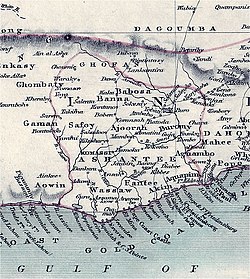
Back Asjantiryk Afrikaans አሻንቲ መንግሥት Amharic إمبراطورية آشانتي Arabic Imperiu asante AST Aşanti imperiyası Azerbaijani آشانتی ایمپراتورلوغو AZB Imperi Aixanti Catalan Ašantská říše Czech Ashantiriget Danish Aschantireich German
Asante Empire Asanteman (Asante Twi) | |||||||||||||
|---|---|---|---|---|---|---|---|---|---|---|---|---|---|
| |||||||||||||
 Map of the Asante Empire | |||||||||||||
| Status | State union with Ghana | ||||||||||||
| Capital | Kumasi | ||||||||||||
| Common languages | Asante (Twi) (official) | ||||||||||||
| Religion | Akan religion | ||||||||||||
| Government | Constitutional Elective Monarchy | ||||||||||||
• 1670–1717 (first) | Osei Tutu | ||||||||||||
• 1888–1896 (13th) | Prempeh I | ||||||||||||
• 1931–1957 (last) | Prempeh II | ||||||||||||
| Osei Tutu II | |||||||||||||
| Legislature | Asante Kotoko (Council of Kumasi)[1] and the Asantemanhyiamu (National Assembly) | ||||||||||||
| History | |||||||||||||
• Established | 1701 | ||||||||||||
• Independence from Denkyira | 1701 | ||||||||||||
• Annexed to form British Ashanti Crown Colony | 1901[2] | ||||||||||||
• Self-rule within British colony | 1935 | ||||||||||||
• State union Ashanti Region with Ghana | 1957 | ||||||||||||
| Present | |||||||||||||
| Area | |||||||||||||
| [3][4] | 259,000 km2 (100,000 sq mi) | ||||||||||||
| Population | |||||||||||||
• [3] | 3,000,000 | ||||||||||||
| Currency |
| ||||||||||||
| |||||||||||||
| Today part of | Ghana
Ivory Coast Togo | ||||||||||||
The Asante Empire (Asante Twi: Asanteman), also known as the Ashanti Empire, was an Akan state that lasted from 1701 to 1901, in what is now modern-day Ghana.[6] It expanded from the Ashanti Region to include most of Ghana and also parts of Ivory Coast and Togo.[7][8] Due to the empire's military prowess, wealth, architecture, sophisticated hierarchy and culture, the Asante Empire has been extensively studied and has more historic records written by European, primarily British, authors than any other indigenous culture of sub-Saharan Africa.[9][10]
Starting in the late 17th century, the Asante king Osei Tutu (c. 1695 – 1717) and his adviser Okomfo Anokye established the Asante Kingdom, with the Golden Stool of Asante as a sole unifying symbol.[6][11] Osei Tutu oversaw a massive Asante territorial expansion, building up the army by introducing new organisation and turning a disciplined royal and paramilitary army into an effective fighting machine.[9] In 1701, the Ashanti army conquered Denkyira, giving the Ashanti access to the Gulf of Guinea and the Atlantic Ocean coastal trade with Europeans, notably the Dutch.[9] The economy of the Asante Empire was mainly based on the trade of gold and agricultural exports[12] as well as slave trading, craft work and trade with markets further north.[5]
The Asante Empire fought several wars with neighboring kingdoms and lesser organized groups such as the Fante. The Asante held their own against the British in the first two of the five Anglo-Ashanti Wars, killing British army general Sir Charles MacCarthy and keeping his skull as a gold-rimmed drinking cup in 1824. British forces later burnt and sacked the Asante capital of Kumasi, however, and following the final Asante defeat at the fifth Anglo-Ashanti War, the Asante empire became part of the Gold Coast colony on 1 January 1902. Today, the Asante Kingdom survives as a constitutionally protected, sub-national traditional state[13] in union with the Republic of Ghana. The current king of the Asante kingdom is Otumfuo Osei Tutu II Asantehene. The Asante kingdom is the home to Lake Bosumtwi, Ghana's only natural lake. The state's current economic revenue is derived mainly from trading in gold bars, cocoa, kola nuts and agriculture.[14]
- ^ Edgerton, Robert B. Fall of the Asante Empire: The Hundred Year War for Africa's Gold Coast. Free Press, 1995.
- ^ Ashanti Order in Council 1901.
- ^ a b Cite error: The named reference
Obeng, J. Pashington page 20was invoked but never defined (see the help page). - ^ Iliffe, John (1995). Africans: The History of a Continent. Cambridge University Press. p. 143. ISBN 9780521484220.
- ^ a b Arhin, Kwame (1990). "Trade, Accumulation and the State in Asante in the Nineteenth Century". Africa: Journal of the International African Institute. 60 (4): 524–537. doi:10.2307/1160206. JSTOR 1160206. S2CID 145522016.
- ^ a b "Osei Tutu | king of Asante empire". Encyclopedia Britannica. Retrieved 30 May 2020.
- ^ Davidson, Basil (29 October 2014). West Africa before the Colonial Era: A History to 1850. Routledge. p. 174. ISBN 978-1-317-88265-7.
- ^ Isichei, Elizabeth (1997). A History of African Societies to 1870. Cambridge University Press. p. 346. ISBN 9780521455992.
- ^ a b c Collins and Burns (2007), p. 140.
- ^ McCaskie (2003), p. 2.
- ^ "Asante Kingdom". Irie Magazine. 31 October 2018. Retrieved 4 December 2020.
- ^ Green, Toby (31 January 2019). A fistful of shells : West Africa from the rise of the slave trade to the age of revolution (Kindle-Version ed.). London: Penguin Books Ltd. pp. 108, 247. ISBN 978-0-241-00328-2.
- ^ Roeder, Philip (2007). Where Nation-States Come From: Institutional Change in the Age of Nationalism. Princeton: Princeton University Press. p. 281. ISBN 978-0691134673.
- ^ Collins and Burns (2007), p. 139.
